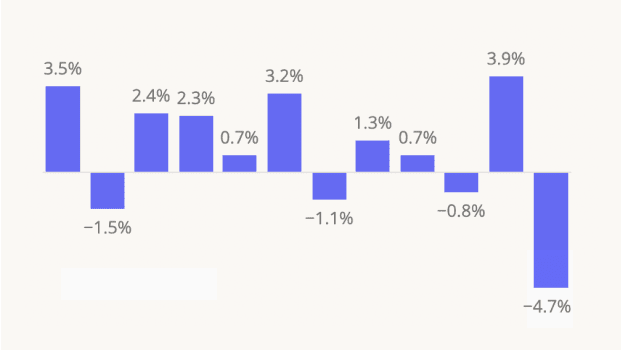
Restaurant Visitation Data Reflects "Two-Tier Economy"
The state of the consumer was top of mind during second-quarter 2025 earnings calls, as restaurant executives consistently described a more cautious and discerning customer. Leaders from major brands like McDonald's, Chipotle, and Starbucks noted that lower-income consumers, in particular, are feeling the pressure of a challenging economy and are pulling back on the frequency of their visits.
McDonald’s CEO Chris Kempczinski framed it as a "two-tier economy," where affluent consumers continue to spend while lower-to-middle income households face significant cost-of-living pressures. This trend is visible in visitation data, which shows quick-service (QSR) and fast-casual restaurants underperforming full-service restaurants and coffee chains in recent months.
This consumer caution has led to a "trade-down" effect, where customers actively seek value-oriented promotions or skip add-ons like a beverage to manage their check size. In response, brands are emphasizing affordable meal bundles – like McDonald’s Extra Value Meals and Taco Bell’s Decades Y2K throwback menu featuring fan-favorites under $3 – and leveraging their loyalty programs to retain these budget-conscious patrons.
Consumer Price Sensitivity Has Elevated Competition Across Food Retail Channels
As 2025 progresses, QSRs face intense competition not just from each other, but from a growing array of value-oriented retailers. Driven by rising menu prices at fast-food chains, highly price-conscious consumers are actively seeking more affordable meal options. Value-oriented grocery stores, dollar stores, and convenience stores have aggressively expanded their grab-and-go and prepared food offerings, making them direct rivals for lunch and dinner.
As the price gap between dining out and eating at home widens, these channels are successfully capturing a greater "share of stomach," particularly from consumers who now view a trip to the grocery or dollar store as a more economical alternative to a QSR visit. We see this in our visitation data, where the number of McDonald’s and other other QSR visitors are increasingly visiting Aldi and other value-oriented options.
Can Fast Casual’s Woes Be Blamed on “Slop Bowl”?
The lunch hour has become a key battleground, with fresh-format and value grocers seeing a notable increase in foot traffic as they expand their high-quality, convenient, and affordable grab-and-go options. This has siphoned off a portion of the traditional lunch crowd from fast-casual restaurants, as consumers – particularly office workers – increasingly opt for a trip to the grocery store.
This pressure contributed to weaker-than-expected results for premium fast-casual chains like Chipotle, Sweetgreen, and CAVA. While these brands were up against tough comparisons from product launches a year ago (Chicken al Pastor for Chipotle, steak options for sweetgreen and CAVA), the slowdown was more significant than anticipated.
What’s to make of this slowdown? In addition to tougher comparisons, the explanation is likely a multi-faceted consumer response to a challenging economic environment and a crowded marketplace. Like QSR chains, many budget-conscious fast-casual customers began trading down, either opting for less expensive fast-food alternatives or simply reducing the frequency of their visits to these pricier lunch spots.
At the same time, a segment of their health-conscious consumer base increasingly turned to specialty grocers like Whole Foods and Trader Joe's, where they could assemble their own high-quality bowls for a lower cost. Compounding the issue was a growing sentiment of "slop bowl" fatigue, a perception that the once-innovative format had become commoditized, with little differentiation between the chains, leading some consumers to seek out more unique dining experiences.
Casual Dining’s Resurgence
Chili's continued its significant outperformance of the restaurant industry in the second quarter of 2025 by successfully executing a multi-faceted strategy centered on a compelling value message that resonated with increasingly price-conscious consumers. The brand's success was largely driven by the popularity of its heavily marketed "3 for Me" bundled meal deal and its "Triple Dipper" appetizer promotion, which together attracted a surge of new and repeat customers. This effective value messaging was supported by substantial investments in marketing and crucial back-of-house operational improvements, which enhanced food quality and service consistency, allowing Chili's to capture a significant share of visits while many competitors in the casual dining space struggled with declining traffic.
It’s not just Chili’s however. Applebee's, for instance, managed to drive a 4.9% increase in same-store sales during its most recent quarter, a significant turnaround attributed to its own value-driven promotions and menu innovations that successfully boosted customer traffic. Olive Garden delivered a solid performance in its most recent quarter, achieving a 2.0% increase in same-restaurant sales. This growth was largely fueled by the success of its value promotions and a significant nearly 20% surge in takeout sales, which helped attract a younger, more frequent customer base according to management.
Value-Seeking Consumer Shaping Dining Trends
As the restaurant industry moves into the second half of 2025, the second quarter's results paint a clear picture of a market defined by a strategic, value-seeking consumer. The resounding success of casual dining chains like Chili's and Applebee's, which leaned heavily into affordable, bundled meals, demonstrates that a compelling value proposition can still drive significant traffic and sales. Conversely, the fast-casual and QSR segments are facing an identity crisis, squeezed by intense competition from lower-priced grocery and convenience store alternatives and the aggressive promotions from sit-down restaurants.
Ultimately, the brands that will thrive for the remainder of the year will be those that can master the art of delivering a strong, clear value equation – whether through price, experience, or convenience – to a customer who is more discerning with their dining dollars than ever before.
For more data-driven insights, visit placer.ai/anchor.
Placer.ai leverages a panel of tens of millions of devices and utilizes machine learning to make estimations for visits to locations across the US. The data is trusted by thousands of industry leaders who leverage Placer.ai for insights into foot traffic, demographic breakdowns, retail sale predictions, migration trends, site selection, and more.

Cautious Consumers Cutting Back on Non-Essential Travel
As the U.S. economy enters the second half of 2025, evidence is mounting that consumers are pulling back on discretionary purchases. This possibility was something we recently discussed when highlighting the divergence between industrial and retail activity. While last week's Amazon Prime Day and other sales events drove a temporary surge in visits for big-ticket and back-to-school items, persistent macroeconomic uncertainty and the first real impacts of tariff-related price increases appear to be taking a toll on consumer confidence. With sentiment remaining fragile, households are becoming more selective, prioritizing essential spending while cutting back on discretionary purchases and travel.
Recently, Placer’s analyst team looked at visitation trends for airports, but we’re also seeing a slowdown in car travel based on visitation data to gas stations. After a sluggish February, foot traffic to gas stations and convenience stores has continued to show year-over-year declines through the spring and into the summer. This trend points to more than just fluctuating fuel prices; it reflects a conscious pullback by consumers who appear to be consolidating trips and reducing non-essential driving. This financial anxiety is causing many to shorten or delay vacation plans, resulting in weaker foot traffic at airports and fewer long-distance road trips.
The Rise of the 'Micro-Cation'
Our analysis confirms that the traditional summer vacation is being reshaped by this economic uncertainty. Using our new Markets data, we’ve seen a decrease in the average miles traveled during the first half of 2025 for roughly two-thirds of the top 25 most populated markets in the U.S.
This has led to a rise in shorter "micro-cations" rather than extended, long-haul journeys. Consequently, while people are still traveling, the overall distance covered per trip has decreased, a sentiment that also extends to air travel, where a slowdown in both leisure and corporate bookings reflects a broad pullback on expensive, long-distance commitments in favor of more predictable, regional getaways.
Cautious Consumer Reshaping the 2025 Retail & Travel Landscape
As we move through July, the consumer narrative for the second half of 2025 is being defined by a strategic retreat in discretionary spending, particularly travel. While major sales events can still create temporary bursts of activity, the underlying trend shows a more cautious consumer responding to economic pressures by reducing non-essential driving, shortening vacation distances, and opting for more budget-friendly "micro-cations." This shift away from long-haul travel, visible in both gas station and airport traffic data, signals a significant recalibration of household budgets that will likely shape the broader retail and travel landscape for the remainder of the year.

July's Pre-Tariff Production Rush
Following a period of caution in May and June, U.S. industrial manufacturing facilities saw a significant surge of activity in July 2025. As we've noted previously, many manufacturers experienced an increase in visits during March and April to build inventory ahead of initial tariff implementation dates, followed by a normalization period in May and June as businesses adopted a "wait-and-see" approach. However, with the hard deadline of August 1st for new, widespread tariffs, July was marked by a dramatic uptick in visits from both employees and logistics partners as companies made a last-ditch effort to maximize output and shipments.
Supply Chains Race Against the Clock
This flurry of activity was particularly intense in highly interconnected sectors like auto manufacturing, industrial machinery, and metals processing, all of which are vulnerable to tariffs on imported raw materials and components. Metals processing plants, for example, ramped up operations to convert as much raw steel and aluminum as possible before their costs increased. In turn, auto and industrial machinery manufacturers accelerated their own production lines, pulling in vast quantities of both processed metals and specialized foreign parts to build up inventory before the new duties could disrupt their supply chains.
This final pre-tariff rush was evident in our data: the increase in employee visits to factories signaled that production lines were running at high capacity, while a sharp rise in visits from logistics partners – like truckers and other carriers – indicated a massive push to move finished goods and components through the supply chain before the August 1st implementation date.
For more data-driven consumer insights, visit placer.ai/anchor.

As competition intensifies from drive-thru rivals and at-home coffee trends, Starbucks is doubling down on unique in-store experiences and AI-powered service improvements to reignite customer visit frequency.
But how likely are these moves to revitalize the company? We dove into the data to find out.
Fostering Loyalty Through Innovation
As the “Back to Starbucks” plan continues to take shape under CEO Brian Niccol, Starbucks finds itself banking on a familiar recipe for success: innovation. The company's recent announcement that it is testing a new protein-enhanced cold foam is a key example of its strategy to re-engage customers. The coffee chain also hopes to boost efficiency and free up employees to engage more with customers through its new “Green Apron” service model.
These moves suggest that Starbucks is focused on driving more consistent and loyal visits through thoughtful menu additions and the restoration of its “coffeehouse feel” rather than relying on temporary discounts – which often provide only a short-term lift without fostering lasting repeat business.
A Robust and Stable Customer Base
This strategic pivot is crucial as the company works to revitalize its brand. And while Starbucks' plans to return to its "coffeehouse roots" will take time to fully implement, it is building from a position of underlying strength. Data shows that the total number of unique customers visiting Starbucks has remained remarkably consistent over the past several years.
Challenge Accepted
However, the core challenge lies in the fact that individual visit frequency has stagnated, meaning those loyal customers are simply coming back less often, turning instead to competitors or at-home coffee. This presents a clear opportunity: If Starbucks can give its large, established customer base new reasons to visit, it can unlock significant growth. And the narrowing of the company’s visit gap in 2025 so far – with both January and April seeing positive year-over-year visit growth – further underscores the company’s underlying strength.
Turnaround Ahead
The urgency for Starbucks’ turnaround is amplified by competition from all sides. The market has seen a surge in new, efficient drive-thru coffee concepts like Dutch Bros, 7 Brew, PJ’s Coffee and others that cater to consumers seeking speed and convenience. Simultaneously, Starbucks faces continued pressure from the at-home coffee trend, with many consumers opting to get their caffeine fix from grocery store purchases. By focusing on unique, in-store-only innovations like protein-boosted beverages, Starbucks aims to give customers an experience they can't replicate at home or get from a faster rival, providing a compelling reason to make that return visit.
For more data-driven dining insights visit Placer.ai/anchor.

As the U.S. economy moves to the midpoint of 2025, a divergent macro picture is starting to take hold. While consumers are showing renewed confidence and returning to stores (or at the very least, responding to heightened promotional activity across many retail categories), the industrial backbone of the economy – manufacturing and shipping – is tapping the brakes. This split narrative suggests that while immediate consumer sentiment has improved as tariff-related news has taken a backseat, industrial signals may be painting a more cautious picture.
Retail Visits Normalize, but are Trends Sustainable?
The retail sector has seen a welcome rebound in May and June, following a sluggish start to the year when macroeconomic uncertainty and significant tariff-related news dampened spirits and hurt foot traffic in February and March. Year-over-year visitation data for the Placer 100 index – a composite of 100 of the largest retail and restaurant chains in the U.S. – indicates that shoppers have likely grown accustomed to the economic climate and are demonstrating more consistent and normal behaviors.
With the initial shock of potential price hikes having passed, consumers appear to be moving past the cautious approach that marked the first quarter, leading to stabilized and improving year-over-year visit trends across many retail categories.
Strength Spanning Multiple Retail Categories
Admittedly, there are multiple factors driving the recent increases in year-over-year retail traffic. Consumers remain squarely focused on value, which continues to drive outperformance for value grocers, warehouse clubs, and dollar stores (which also appear to be benefiting from less competition from Temu and Shein amid new regulatory restrictions). Off-price retailers continue to be one of the strongest performing categories year-to-date, capitalizing on increased inventory opportunities stemming from recent store closures and tariff-related supply chain disruptions, allowing them to fuel their "treasure hunt" model. Finally, traditional department stores have also contributed to the rebound through strong reception to events like Nordstrom’s Half-Yearly Sale and other promotional activity.
A Cautious Industrial Sector
While retail visits have normalized in recent weeks, a different story is unfolding across U.S. factories and ports. Following a production surge in late March and April – when manufacturers ramped up activity to build inventory ahead of tariff deadlines – both manufacturing and port activity have seen a notable decline in May and into June.
Placer’s Industrial Manufacturing composite indicates that activity at manufacturing facilities – representing visits for both facility employees (estimated based on dwell time) and visitors, who often represent logistics partners – slowed in May and June.
Looking at manufacturing visit data by category, many U.S. factories took a breather in May, with our data showing a widespread slowdown in visits. The auto and auto parts industry has been hit particularly hard, feeling the direct impact of international tariffs. But this isn't just a car story – most other manufacturing sectors also pumped the brakes, signaling that many companies are cautiously getting ready for what could be an unpredictable second half of the year.
Port Data Also Raises Concerns
Slowing new orders and decreasing container volumes at major ports suggest that businesses, having already front-loaded their inventory, are now taking a more cautious look toward the second half of 2025. Many appear hesitant to over-commit amidst an unpredictable trade policy landscape.
Our visitation data for some of the busiest ports in the U.S. generally shows a strong correlation with the Bureau of Transportation's container import and export statistics. While our data indicated increased activity at several Eastern ports ahead of initial tariff implementation dates in early April, we have since observed visitation trends declining through much of April and May. The one notable exception is the Port of Houston – where gasoline imports are often received – which saw a spike in activity in May that has continued through June.
Shoppers Return, Factories Slow
The two-track U.S. economy at the mid-point of 2025 highlights a clear divergence between consumer behavior and industrial strategy. While shoppers have returned to stores, driven by a hunt for value and successful promotions, the industrial sector is sending more cautious signals. The slowdown in activity at manufacturing facilities and ports suggests that businesses, having already front-loaded inventory ahead of tariffs, are now bracing for potential volatility. This sets up a classic economic tug-of-war for the second half of the year, leaving a critical question: Will resilient consumer spending eventually pull the industrial sector back into a growth cycle, or will the manufacturing slowdown ultimately impact supply chains, shelf availability, and the recent retail rebound?
For more data-driven retail insights, visit placer.ai/anchor.

Visitation Data Reveals Shifting Tides in U.S. Manufacturing
When we reviewed March 2025 visitation data for industrial manufacturing facilities across the U.S. – encompassing visits from both employees and logistics partners – our data indicated an uptick in activity. Notably, many industrial manufacturers, particularly in sectors like aerospace, automotive, and packaging, increased activity as they proactively ramped up production in anticipation of potential tariff-related disruptions.
While the official U.S. Census Bureau data on manufacturing new orders for April and May 2025 is not yet available (with April's full M3 report expected around June 3rd and May's around July 3rd), visitation data from our industrial manufacturing composite for April 2025 was reflective of the evolving tariff landscape that many manufacturers have faced the past several weeks. Overall, our industrial manufacturing composite for April and early May 2025 indicates that visits to manufacturing facilities have decreased year-over-year.
Several factors could contribute to this decrease: (1) general consumer uncertainty about the economy, which has impacted retail visits this year and may be dampening industrial demand; and (2) previously announced extensions to some tariff implementation dates, which might have led businesses to pause or adjust orders. Separately, the tariff environment saw a new development with the temporary reduction in certain U.S.-China tariffs enacted in mid-May; this change may lead to shifts in activity going forward but would not explain the decrease observed in April and early May.
Larger Visit Boosts to Categories With Greater Tariff Exposure
Were there manufacturing categories that saw greater year-over-year visitation trends than others? Unsurprisingly, categories that are potentially impacted by tariff activity – such as metals (including steel and aluminum) and electrical equipment – continued to see the greatest year-over-year increase in visits in April as manufacturers accelerated production ahead of tariff implementations or companies switched to goods produced in the United States (as shown below). General Dynamics, Howmet Aeropace, U.S. Steel, Nucor, and Powell Industries were among the manufacturers that stood out with respect to visit activity during April 2025.
Automakers Adjust to Tariff Aftershocks
Our previous analysis of Ford and General Motors manufacturing facilities indicated an uptick in visitation during late March and early April 2025. This surge likely reflected an effort by these automakers to accelerate production and build inventory ahead of significant tariff changes, including the 25% tariffs on imported vehicles that took effect on April 3rd and anticipated levies on auto parts.
However, in subsequent weeks, our visitation data indicated a return to more typical visitation levels for both manufacturers. These more subdued year-over-year visit trends likely indicate a period of adjustment and caution, aligning with the broader market uncertainty. The considerable financial impact from tariffs also led both Ford and General Motors to revise their 2025 financial guidance in early May, despite some discussions around partial tariff relief measures during that period.
Post-Tariff Uncertainty Cools Manufacturing Rush
Given the fluid and constantly evolving landscape for industrial manufacturers, what are the key takeaways? Our data shows a clear pull-forward in demand among manufacturers during March, as they ramped up production schedules ahead of tariff implementations, especially in sectors like metals and aerospace. However, this initial surge was followed by a cooling off in activity during April and early May, likely stemming from general tariff uncertainty.
Keep up with The Anchor to see where industrial manufacturing activity heads next.

Introduction
2024 has been another challenging year for retailers. Still-high prices and an uncertain economic climate led many shoppers to trade down and cut back on unnecessary indulgences. Value took center stage, as cautious consumers sought to stretch their dollars as far as possible.
But price wasn’t the only factor driving consumer behavior in 2024. This past year saw the rise of a variety of retail and dining trends, some seemingly at odds with one another. Shoppers curbed discretionary spending, but made room in their budgets for “essential non-essentials” like gym memberships and other wellness offerings. Consumers placed a high premium on speed and convenience, while at the same time demonstrating a willingness to go out of their way for quality or value finds. And even amidst concern about the economy, shoppers were ready to pony up for specialty items, legacy brands, and fun experiences – as long as they didn’t break the bank.
How did these currents – likely to continue shaping the retail landscape into 2025 – impact leading brands and categories? We dove into the data to find out.
Conventional Value Reaching Its Ceiling
Bifurcation has emerged as a foundational principle in retail over the past few years: Consumers are increasingly gravitating toward either luxury or value offerings and away from the ‘middle.’ Add extended economic uncertainty along with rapid expansions and product diversification from top value-oriented retailers, and you have an explosion of visits in the value lane.
But we are seeing a ceiling to that growth – especially in the discount & dollar store space. Throughout 2023 and the first part of 2024, visits to discount & dollar stores increased steadily. But no category can sustain uninterrupted visit growth forever. Since April 2024, year–over-year (YoY) foot traffic to the segment has begun to slow, with September 2024 showing just a modest 0.8% YoY visit increase.
Discount & dollar stores, which attract lower-income shoppers compared to both grocery stores and superstores, have also begun lagging behind these segments in visit-per-location growth. In Q3, the average number of visits to each discount and dollar store location remained essentially flat compared to 2023 (+0.2%), while visits per location to superstores and grocery stores grew by 2.8% and 1.0%, respectively. As 2024 draws to a close, it is the latter segments, which appeal to shoppers with incomes closer to the nationwide median of $76.1K, which are seeing better YoY performance.
The deceleration doesn’t mean that discount retailers are facing existential risk – discount & dollar stores are still extremely strong and well-positioned with focused offerings that resonate with consumers. The visitation data does suggest, however, that future growth may need to focus on initiatives other large-scale fleet expansions. Some of these efforts will involve moving upmarket (see pOpShelf), some will focus on fleet optimization, and others may include new offerings and channels.
Return of the middle anyone?
Innovative and Disruptive Value Shake Up Retail and Dining
Still, in an environment where consumers have been facing the compounded effects of rising prices, value remains paramount for many shoppers. And brands that have found ways to let customers have their cake and eat it too – enjoy specialty offerings and elevated experiences without breaking the bank – have emerged as major visit winners this year.
Trader Joe’s Drives Visits With Private Label Innovation
Trader Joe’s, in particular, has stood out as one of the leading retail brands for innovative value in 2024, a trend that is expected to continue into 2025.
Trader Joe’s dedicated fan base is positively addicted to the chain’s broad range of high-quality specialty items. But by maintaining a much higher private label mix than most grocers – approximately 80%, compared to an industry average of 25% to 30% – the retailer is also able to keep its pricing competitive. Trader Joe’s cultivates consumer excitement by constantly innovating its product line – there are even websites dedicated to showcasing the chain’s new offerings each season. In turn, Trader Joe’s enjoys much higher visits per square foot than the rest of the grocery category: Over the past twelve months, Trader Joe’s drew a median 56 visits per square foot – compared to 23 for H-E-B, the second-strongest performer.
Chili’s Beats QSR at its Own Game
Casual dining chain Chili’s has also been a standout on the disruptive value front this past year – offering consumers a full-service dining experience at a quick-service price point.
Chili’s launched its Big Smasher Burger on April 29th, 2024, adding the item to its popular ‘3 for Me’ offering, which includes an appetizer, entrée, and drink for just $10.99 – lower than than the average ticket at many quick-service restaurant chains. The innovative promotion, which has been further expanded since, continues to drive impressive visitation trends. With food-away-from-home inflation continuing to decelerate, this strategy of offering deep discounts is likely to continue to be a key story in 2025.
The Convenience Myth
Convenience is king, right?
Well, probably not. If convenience truly were king, visitors would orient themselves to making fewer, longer visits to retailers – to minimize the inconvenience of frequent grocery trips and spend less time on the road. But analyzing the data suggests that, while consumers may want to save time, it is not always their chief concern.
Looking at the superstore and grocery segments (among others) reveals that the proportion of visitors spending under 30 minutes at the grocery store is actually increasing – from 73.3% in Q3 2019 to 76.6% in Q3 2024. This indicates that shoppers are increasingly willing to make shorter trips to the store to pick up just a few items.
At the same time, more consumers than ever are willing to travel farther to visit specialty grocery chains in the search of specific products that make the visit worthwhile.
Cross visitation between chains is also increasing – suggesting that shoppers are willing to make multiple trips to find the products they want – at the right price point. Between Q3 2023 and Q3 2024, the share of traditional grocery store visitors who also visited a Costco at least three times during the quarter grew across chains.
Does this mean convenience doesn’t matter? Of course not. Does it indicate that value, quality and a love of specific products are becoming just as, if not more, important to shoppers? Yes.
The implications here are very significant. If consumers are willing to go out of their way for the right products at the right price points – even at the expense of convenience – then the retailers able to leverage these ‘visit drivers’ will be best positioned to grow their reach considerably. The willingness of consumers to forego convenience considerations when the incentives are right also reinforces the ever-growing importance of the in-store experience.
So while convenience may still be within the royal family, the role of king is up for grabs.
Serving Diners Quicker With Automatization
Chipotle Draws Crowds With Autocado
Convenience may not be everything, but the drive for quicker service has emerged as more important than ever in the restaurant space. Diners want their fast food… well, as fast as possible. And to meet this demand, quick-service restaurants (QSRs) and fast-casual chains have been integrating more technology into their operations. Chipotle has been a leader in this regard, unveiling the “Autocado” robot at a Huntington Beach, California location last month. The robot can peel, pit, and chop avocados in record time, a major benefit for the Tex-Mex chain.
And the Autocado seems to be paying off. The Huntington Beach location drew 10.0% more visits compared to the average Chipotle location in the Los Angeles-Long Beach-Anaheim metro area in Q3 2024. Visitors are visiting more frequently and getting their food more quickly – 43.9% of visits at this location lasted 10 minutes or less, compared to 37.5% at other stores in the CBSA.
Are diners flocking to this Chipotle location to watch the future of avocado chopping in action, or are they enticed by shorter wait times? Time will tell. But with workers able to focus on other aspects of food preparation and customer service, the innovation appears to be resonating with diners.
McDonald’s Leans into Automation in Texas
McDonald’s, too, has leaned into new technologies to streamline its service. The chain debuted its first (almost) fully automated, takeaway-only restaurant in White Settlement, TX in 2022 – where orders are placed at kiosks or on app, and then delivered to customers by robots. (The food is still prepared by humans.) Unsurprisingly, the restaurant drives faster visits than other local McDonald’s locations – in Q3 2023, 79.7% of visits to the chain lasted less than 10 minutes, compared to 68.5% for other McDonald’s in the Dallas-Fort Worth-Arlington, TX CBSA. But crucially, the automated location is also busier than other area McDonald’s, garnering 16.8% more visits in Q3 than the chain’s CBSA-wide average. And the location draws a higher share of late-night visits than other area McDonald’s – customers on the hunt for a late-night snack might be drawn to a restaurant that offers quick, interaction-free service.
Evolving Retail Formats - Finding the Right Fit
Changing store formats is another key trend shaping retail in 2024. Whether by reducing box sizes to cut costs, make stores more accessible, or serve smaller growth markets – or by going big with one-stop shops, retailers are reimagining store design. And the moves are resonating with consumers, driving visits while at the same improving efficiency.
Macy’s Draws Local Weekday Visitors With Small-Format Stores
Macy’s, Inc. is one retailer that is leading the small-format charge this year. In February 2024, Macy’s announced its “Bold New Chapter” – a turnaround plan including the downsizing of its traditional eponymous department store fleet and a pivot towards smaller-format Macy’s locations. Macy’s has also continued to expand its highly-curated, small-format Bloomie’s concept, which features a mix of established and trendy pop-up brands tailored to local preferences.
And the data shows that this shift towards small format may be helping Macy’s drive visits with more accessible and targeted offerings that consumers can enjoy as they go about their daily routines: In Q3 2024, Macy’s small-format stores drew a higher share of weekday visitors and of local customers (i.e. those coming from less than seven miles away) than Macy’s traditional stores.
Harbor Freight Tools and Ace Hardware Serve Smaller Growth Markets With Less Square Footage
Small-format stores are also making inroads in the home improvement category. The past few years have seen consumers across the U.S. migrating to smaller suburban and rural markets – and retailers like Harbor Freight Tools and Ace Hardware are harnessing their small-format advantage to accommodate these customers while keeping costs low.
Harbor Freight tools and Ace Hardware’s trade areas have a high degree of overlap with some of the highest growth markets in the U.S., many of which have populations under 200K. And while it can be difficult to justify opening a Home Depot or Lowe’s in these hubs – both chains average more than 100,000 square feet per store – Harbor Freight Tools and Ace Hardware’s smaller boxes, generally under 20,000 square feet, are a perfect fit.
This has allowed both chains to tap into the smaller markets which are attracting growing shares of the population. And so while Home Depot and Lowe’s have seen moderate visits declines on a YoY basis, Harbor Freight and Ace Hardware have seen consistent YoY visit boosts since Q1 2024 – outperforming the wider category since early 2023.
Hy-Vee Bucks the Trend by Going Big
Are smaller stores a better bet across the board? At the end of the day, the success of smaller-format stores depends largely on the category. For retail segments that have seen visit trends slow since the pandemic – home furnishings and consumer electronics, for example – smaller-format stores offer brands a more economical way to serve their customers. Retailers have also used smaller-format stores to better curate their merchandise assortments for their most loyal customers, helping to drive improved visit frequency.
That said, a handful of retailers, such as Hy-Vee, have recently bucked the trend of smaller-format stores. These large-format stores are often designed as destination locations – Hy-Vee’s larger-format locations usually offer a full suite of amenities beyond groceries, such as a food hall, eyewear kiosk, beauty department, and candy shop. Rather than focusing on smaller markets, these stores aim to attract visitors from surrounding areas.
Visit data for Hy-Vee’s large-format store in Gretna, Nebraska indicates that this location sees a higher percentage of weekend visits than other area locations – 37.7% compared to 33.1% for the chain’s Omaha CBSA average – as well as more visits lasting over 30 minutes (32.9% compared to 21.9% for the metro area as a whole). For these shoppers, large-format, one-stop shops offer a convenient – and perhaps more exciting – alternative to traditionally sized grocery stores. The success of the large-format stores is another sign that though convenience isn’t everything in 2024, it certainly resonates – especially when paired with added-value offerings.
A Resurgence of Legacy Brands
Many retail brands have entrenched themselves in American culture and become an extension of consumers' identities. And while some of these previously ubiquitous brands have disappeared over the years as the retail industry evolved, others have transformed to keep pace with changing consumer needs – and some have even come back from the brink of extinction. And the quest for value notwithstanding, 2024 has also seen the resurgence of many of these (decidedly non-off-price) legacy brands.
In apparel specifically, Gap and Abercrombie & Fitch – two brands that dominated the cultural zeitgeist of the 1990s and early 2000s before seeing their popularity decline somewhat in the late aughts and 2010s – may be staging a comeback. Bed Bath & Beyond, a leader in the home goods category, is also making a play at returning to physical retail through partnerships.
Anthropologie, another legacy player in women’s fashion and home goods, is also on the rise. Anthropologie’s distinctive aesthetic resonates deeply with consumers – especially women millennials aged 30 to 45. And by capturing the hearts of its customers, the retailer stands as a beacon for retailers that can hedge against promotional activity and still drive foot traffic growth.
And visits to the chain have been rising steadily. In Q4 2023, the chain experienced a bigger holiday season foot traffic spike than pre-pandemic, drawing more overall visits than in Q4 2019. And in Q3 2024, visits were higher than in Q3 2023.
Meeting the Evolving Needs of Millennials
And speaking of the 35 to 40 set – the generation that all retailers are courting? Millennials. Does that sound familiar? Yes, because this is the same generational cohort that retailers tried to target a decade ago. As millennials have aged into the family-formation stage of life, their retail needs have evolved, and the industry is now primed to meet them.
Sam’s Club Draws Value-Conscious Singles and Starters
From the revival of nostalgic brands like the Limited Too launch at Kohl’s to warehouse clubs expanding memberships to younger consumers as they move to suburban and rural communities, there are myriad examples of retailers reaching out to this cohort. And Sam’s Club offers a prime example of this trend.
Over the past few years, millennials and Gen-Zers have emerged as major drivers of membership growth at Sam’s Club, drawn to the retailer’s value offerings and digital upgrades – like the club’s Scan & Go technology. Over the same period, Sam’s Club has grown the share of “Singles and Starters” households in its captured market from 6% above the national benchmark in Q3 2019 to 15% in Q3 2024. And with plans to involve customers in co-creating products for its private-label brand, Sam’s Club may continue to grow its market share among this value-conscious – but also discerning and optimistic – demographic.
Taco Bell Brings in Crowds With Value Nostalgia Menu
Millennials are also now old enough to wax nostalgic about their youth – and brands are paying attention. This summer, Taco Bell leaned into nostalgia with a promotion bringing back iconic menu items from the 60s, 70s, 80s, and 90s – all priced under $3. The promotion, which soft-launched at three Southern California locations in August, was so successful that the company is now offering the specials nationwide. The three locations that trialed the “Decades Menu” saw significant boosts in visits during the promotional period compared to their daily averages for August. And people came from far and wide to sample the offerings – with a higher proportion of visitors traveling over seven miles to reach the stores while the items were available.
What Lies Ahead?
Hot on the heels of a tumultuous 2023, 2024’s retail environment has certainly kept retailers on their toes. While embracing innovative value has helped some chains thrive, other previously ascendant value segments, including discount & dollar stores, may have reached their growth ceilings. Consumers clearly care about convenience – but are willing to make multiple grocery stops to find what they need. At the same time, legacy brands are plotting their comeback, while others are harnessing the power of nostalgia to drive millennials – and other consumers – through their doors.




.svg)





.png)
.png)

.png)
.png)



